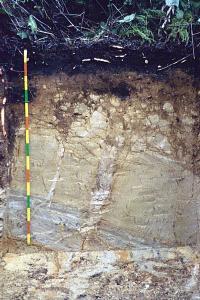Reference soil Indonesia 27: Andosol
Andosols occur throughout the world where volcanic activity is common, especially in the circum-Pacific region and along the mid-Atlantic Ridge.
Characteristics
Soils with a vitric or andic horizon (slightly to moderately weathered horizons in pyroclastic deposits dominated by short-range-order minerals, notably allophane and imogolite) starting within 25 cm from the soil surface. In addition, they may have a histic, fulvic, melanic, mollic, umbric, ochric, duric, or cambic horizon. Other diagnostic horizons (unless buried deeper than 50 cm by volcanic deposits) are absent.
Reference soil ID027: Andosols
LOCATION: The Indonesian monolith number is Sumut01. PARENT MATERIAL: Toba tuff originates from an ash flow. It has a sandy texture, the sand consist for the larger part of translucent fragments, probably mainly volcanic glass. HYDROLOGY: After heavy rain, water stagnates on the soil surface in isolated spots. VEGETATION: The Kemenyan trees were planted 15 to 20 years ago (for resin collection). ADDITIONAL NOTES ON PROFILE DESCRIPTION: B - thickness varies locally; in general between 20 and 60 cm; pockets of C material; about 15% of the surface is stained by organic matter. C - contains thin iron fibres.
